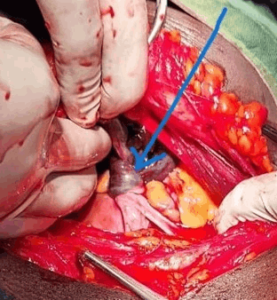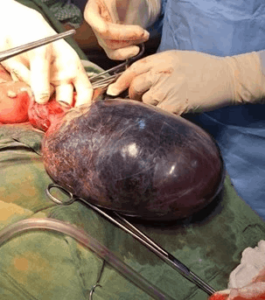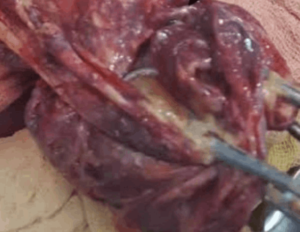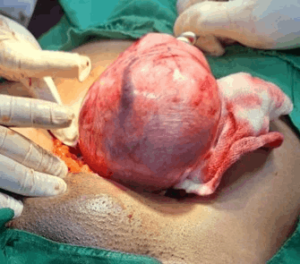Author's details
- Dr. Solaja Olufemi. Augustine
- (MBChB, FWACS)
- HOD, Department of Obstetrics and Gynaecology, General Hospital Mushin. Lagos, Nigeria.
Reviewer's details
- Dr Jimoh Olanrewaju Saheed
- MBBS, FMCOG,MBA, FICS.
- Department of Obstetrics and Gynaecology, Federal Medical Centre, Abeokuta, Nigeria.
- Date Uploaded: 2025-03-19
- Date Updated: 2025-03-19
Ovarian Cysts and Ovarian Accidents
Summary
Ovarian Cysts are quite common amongst women of reproductive age group, though they can affect women from fetal life to old age (1). It is the 4th commonest reason for admission into the gynaecological ward and at least 4 % of women would have been admitted once before the age of 65years (2,3). It accounts for 6% of gynaecological surgeries contributing majorly to the admission in the primary and secondary health centers in Nigeria (4,5).
Ovarian cyst accidents, such as rupture or torsion, are medical emergencies that can occur when fluid-filled sacs on the ovaries burst or twist. In sub-Saharan Africa, where access to healthcare may be limited, delayed diagnosis and treatment can increase the risk of complications like internal bleeding, infection, or infertility. Symptoms include sudden, severe abdominal pain, nausea, and vomiting. Raising awareness and improving access to timely medical care are essential for managing these conditions and preventing serious health outcomes for women in the region.
The aetiology of ovarian cysts is not fully known, however, there are theories, and they include: ovarian cysts might be caused by genetic factors, increasing resistance of the body to insulin, obesity, and infections, an imbalance between the production of androgens and oestrogen, the body produces more androgen hormones when compared to the estrogen hormones (4).
Ovarian cyst accidents are usually caused by rupture or torsion, in sub-Saharan African settings is influenced by various factors. These include hormonal imbalances, which may lead to the formation of functional cysts, particularly in reproductive-age women. Limited access to routine gynecological care and family planning services can result in undiagnosed cysts that grow larger, increasing the risk of accidents.
Most ovarian cysts are asymptomatic and usually disappear spontaneously (especially when they are clear and simple cysts), they typically do not give any symptoms or signs when they are less than 5 cm in diameter, however when they are more than 5cm they can give the following symptoms(6,7).
They may cause discomfort in the abdomen, a feeling of being bloated, pelvic pain, dysmenorrhea, and dyspareunia. Other symptoms are nausea, vomiting, breast tenderness, fullness and heaviness in the abdomen, and frequency and difficulty with emptying of the bladder.
The pain can present as a dull ache, pain in the lower back or abdomen, on and off pelvic pain. Acute severe pain can occur in complicated ovarian cysts such as torsion, infarction, or haemorrhage(6).
Some common types of cysts
| Follicular cyst | Lutein cyst | Granulosa lutein |
| Theca lutein | Endometrioma | Dermoid Cyst |
Cyst adenomas (Serous, Mucinous)
The following are causes of acute abdomen in a woman with ovarian cyst: (2,4)
Torsion
Ovarian cyst torsion should be described as an ovarian adnexal torsion, because it is the adnexa that twists usually due to the size of the ovarian cyst. It is defined as partial or complete rotation of the ovarian vascular pedicle to the ovary obstructing venous outflow and later arterial inflow, leading to severe pain.

Pic 1. Arrow showing a left-sided adnexal torsion (Picture credit from Dr. Solaja Olufemi. Augustine)
Ovary has a cortex which is its outer covering rich in primordial follicles and is more vascular. During the monthly distension of ovaries by the growing follicular cyst for ovulation, a small vessel in the wall of the distension can rupture leading to blood collection into the cyst itself or into the peritoneal cavity.
Due to distensible quality of the covering, there may not be any pain or tenderness. Bleeding from small vessels is usually self-limiting and only leads to a change in the colour of the cyst contents. Rupture of bigger vessels leads to severe pain or massive intraperitoneal bleeding.

Pic 2. A huge haemorrhagic ovarian cyst. (Picture credit from Dr. Solaja Olufemi. Augustine)
Rupture is more likely to happen if the cyst wall is damaged by previous ischaemic degeneration or if it is malignant. It can also be spontaneous and at times external factors such as trauma, pelvic examination, coitus, or childbirth can also precipitate rupture Pic 3.

Pic 3: Ovarian Rupture (Picture credit from Dr Saheed Jimoh)
A cyst can be infected by direct spread of organisms from adjacent actively infected structures e.g. acute salpingitis or pelvic peritonitis. Cysts (Pic 4), which has gone through ischaemic necrosis, or that have been treated by tapping rather than by removal are more likely to be infected.
These cases present with fever & abdominal pain, and a tender mass is felt through the fornix.

Pic 4. A left Dermoid Ovarian Cyst. (Picture credit from Dr. Solaja Olufemi. Augustine)
The diagnosis of ovarian cysts accidents is very challenging and needs a high level of suspicion and a great deal of good clinical acumen. The diagnosis usually starts from a detailed history, a thorough examination and important necessary investigations (2,4).
Examination is essential to diagnosing patients with cysts accidents and also rule out differential diagnosis of this condition.
Symptoms and signs will largely depend on the possible type of accident, one cardinal symptom to all is abdominal pain and or tenderness.
There may be tachycardia, on abdominal examination there will be tenderness, there could be marked guarding & rigidity and there may be a mass arising from the pelvis and the mass may be tender. The mass may displace the uterus to the other side (1).
Investigations are needed to make accurate diagnoses especially in those with subacute presentations, this also helps to rule out differentials, but those with very acute presentations may need very urgent interventions. Investigations which will include:(1,2,4).
- Ultrasound: This is readily available and easily accessible as a mode of evaluation in sub-Saharan Africa.
- Colour doppler.
- Pregnancy test: Ovarian cysts can occur in pregnant women and it is important to do a pregnancy test, transvaginal ultrasound and histology to avoid missing ovarian cyst accidents and confusing it with ectopic pregnancy.
- Complete blood count
- Electrolyte, urea and creatinine
- Grouping and crossmatching
- Computer Tomography and Magnetic Resonance Imaging are not widely available in low-income settings.
These can be divided into gynaecological and non-gynaecological
Gynaecological causes of acute abdomen include ectopic pregnancy, pelvic inflammatory disease and tubo-ovarian abscess.
Non-gynaecological causes are: acute appendicitis, diverticulitis, ureteric colic, intestinal obstruction, urinary tract infection and ureteric calculi.
Ovarian cyst itself can be managed conservatively, some resolves spontaneously, however, once a cyst is large (≥5cm) diameter, it can be complicated by an accident, then the patient needs immediate surgical intervention to preserve ovarian function where possible, and a unilateral ovariectomy is also applicable in some cases. The surgery could be by laparoscopy or by laparotomy depending on the state of the patient, the type of accident and the available resources and skills for laparoscopy.
Asides the surgical intervention, other important salient features of the surgery would include, untwisting the mass, assessment of tissue viability, cystectomy while preserving the normal ovarian tissue & restoring near normal anatomy.
In the case of haemorrhagic cyst presenting with shock, the management of shock should immediately be instituted. (1,2,4).
It is documented that ovarian cysts can be prevented through a proper healthy diet, preventing weight gain, regular exercise, ensuring a stable menstrual cycle, routine medical examination, avoiding smoking, staying off carbonated drinks, the use of oral contraceptive pills. The failure to ensure that these preventive measures are taken could further increase the risk of ovarian cysts (1,4,8).
Preventing ovarian cyst accidents involves early detection, hormonal regulation, education, and improved healthcare access. Regular gynecological care and ultrasounds can identify cysts early, while hormonal treatments help prevent their formation. Raising awareness of symptoms encourages timely medical attention. In sub-Saharan Africa, improving access to healthcare facilities and treating underlying conditions like PCOS or infections are vital for reducing risks. For large or high-risk cysts, elective surgery can prevent emergencies, helping to lower the occurrence of cyst accidents in the region.
Ovarian cysts are quite common in the reproductive age group, but cysts accidents are unwanted complications that could arise but early diagnosis and treatment will prevent unwanted complications. Advocacy and education should be promoted on preventive measures amongst women of reproductive age.
Cultural practices and barriers to healthcare access, such as reliance on traditional medicine and socioeconomic constraints, can delay medical intervention, allowing cysts to persist and become complicated. Additionally, conditions like pelvic infections, commonly seen in areas with limited reproductive health services, may contribute to the development of more complex cysts, heightening the risk of rupture or torsion. Improved access to preventive healthcare is crucial to addressing these challenges.
A 28-year-old woman from rural sub-Saharan Africa presented with severe abdominal pain, nausea, and vomiting. She had a history of irregular menstrual cycles but had not sought prior medical care due to financial and logistical barriers. An ultrasound revealed ovarian torsion caused by a large cyst. Delays in transferring her to a hospital with surgical facilities led to an emergency laparotomy, where the cyst was removed and the ovary untwisted. Despite complications like internal bleeding and the need for blood transfusions, she recovered, though her future fertility remained uncertain.
- Jyoti M. Accidents to ovarian cysts. J Univers Coll Med Sci. 2013;1(2):46–53.
- Sorinola O, Cox C. Accidents to ovarian cysts. Obstet Gynaecol. 2002;4(1):10–5.
- Bottomley C, Bourne T. Diagnosis and management of ovarian cyst accidents. Best Pract Res Clin Obstet Gynaecol [Internet]. 2009;23(5):711–24. Available from: https://www.sciencedirect.com/science/article/pii/S152169340900042X
- Numa SE. The Influence Of Environmental Factors On The Incidence Of Ovarian Cysts Among Nigerian Women–A Systematic Review.
- Ekweani JC, Oguntayo A, Kolawole A, Zayyan M. An 8-year review of ovarian cyst accidents at a tertiary health center in Northwestern Nigeria. Trop J Obstet Gynaecol. 2016 1;33:307.
- Abduljabbar HS, Bukhari YA, Al Hachim EG, Ashour GS, Amer AA, Shaikhoon MM, et al. Review of 244 cases of ovarian cysts. Saudi Med J. 2015;36(7):834.
- Lim WH, Woods N, Lamaro VP. Trends and outcomes of ruptured ovarian cysts. Postgrad Med J [Internet]. 2022 Jul 1;98(1161):e9–e9. Available from: https://doi.org/10.1136/postgradmedj-2020-138833
- Smith-Bindman R, Poder L, Johnson E, Miglioretti DL. Risk of malignant ovarian cancer based on ultrasonography findings in a large unselected population. JAMA Intern Med. 2019;179(1):71–7.
- Njamen TN, Tchounzou R, Tolefac PN, Nguefack CT, Emmanuella M, et al. (2019) Emergency Laparoscopy for a Rupture of an Ovarian Cyst in Early Pregnancy: What have we Learned?. Arch Obstet Gynecol Reprod Med, 2(1): 32-34.

Author's details
Reviewer's details
Ovarian Cysts and Ovarian Accidents
- Background
- Symptoms
- Clinical findings
- Differential diagnosis
- Investigations
- Treatment
- Follow-up
- Prevention and control
- Further readings
Ovarian Cysts are quite common amongst women of reproductive age group, though they can affect women from fetal life to old age (1). It is the 4th commonest reason for admission into the gynaecological ward and at least 4 % of women would have been admitted once before the age of 65years (2,3). It accounts for 6% of gynaecological surgeries contributing majorly to the admission in the primary and secondary health centers in Nigeria (4,5).
Ovarian cyst accidents, such as rupture or torsion, are medical emergencies that can occur when fluid-filled sacs on the ovaries burst or twist. In sub-Saharan Africa, where access to healthcare may be limited, delayed diagnosis and treatment can increase the risk of complications like internal bleeding, infection, or infertility. Symptoms include sudden, severe abdominal pain, nausea, and vomiting. Raising awareness and improving access to timely medical care are essential for managing these conditions and preventing serious health outcomes for women in the region.
- Jyoti M. Accidents to ovarian cysts. J Univers Coll Med Sci. 2013;1(2):46–53.
- Sorinola O, Cox C. Accidents to ovarian cysts. Obstet Gynaecol. 2002;4(1):10–5.
- Bottomley C, Bourne T. Diagnosis and management of ovarian cyst accidents. Best Pract Res Clin Obstet Gynaecol [Internet]. 2009;23(5):711–24. Available from: https://www.sciencedirect.com/science/article/pii/S152169340900042X
- Numa SE. The Influence Of Environmental Factors On The Incidence Of Ovarian Cysts Among Nigerian Women–A Systematic Review.
- Ekweani JC, Oguntayo A, Kolawole A, Zayyan M. An 8-year review of ovarian cyst accidents at a tertiary health center in Northwestern Nigeria. Trop J Obstet Gynaecol. 2016 1;33:307.
- Abduljabbar HS, Bukhari YA, Al Hachim EG, Ashour GS, Amer AA, Shaikhoon MM, et al. Review of 244 cases of ovarian cysts. Saudi Med J. 2015;36(7):834.
- Lim WH, Woods N, Lamaro VP. Trends and outcomes of ruptured ovarian cysts. Postgrad Med J [Internet]. 2022 Jul 1;98(1161):e9–e9. Available from: https://doi.org/10.1136/postgradmedj-2020-138833
- Smith-Bindman R, Poder L, Johnson E, Miglioretti DL. Risk of malignant ovarian cancer based on ultrasonography findings in a large unselected population. JAMA Intern Med. 2019;179(1):71–7.
- Njamen TN, Tchounzou R, Tolefac PN, Nguefack CT, Emmanuella M, et al. (2019) Emergency Laparoscopy for a Rupture of an Ovarian Cyst in Early Pregnancy: What have we Learned?. Arch Obstet Gynecol Reprod Med, 2(1): 32-34.

Content
Author's details
Reviewer's details
Ovarian Cysts and Ovarian Accidents
Background
Ovarian Cysts are quite common amongst women of reproductive age group, though they can affect women from fetal life to old age (1). It is the 4th commonest reason for admission into the gynaecological ward and at least 4 % of women would have been admitted once before the age of 65years (2,3). It accounts for 6% of gynaecological surgeries contributing majorly to the admission in the primary and secondary health centers in Nigeria (4,5).
Ovarian cyst accidents, such as rupture or torsion, are medical emergencies that can occur when fluid-filled sacs on the ovaries burst or twist. In sub-Saharan Africa, where access to healthcare may be limited, delayed diagnosis and treatment can increase the risk of complications like internal bleeding, infection, or infertility. Symptoms include sudden, severe abdominal pain, nausea, and vomiting. Raising awareness and improving access to timely medical care are essential for managing these conditions and preventing serious health outcomes for women in the region.
Further readings
- Jyoti M. Accidents to ovarian cysts. J Univers Coll Med Sci. 2013;1(2):46–53.
- Sorinola O, Cox C. Accidents to ovarian cysts. Obstet Gynaecol. 2002;4(1):10–5.
- Bottomley C, Bourne T. Diagnosis and management of ovarian cyst accidents. Best Pract Res Clin Obstet Gynaecol [Internet]. 2009;23(5):711–24. Available from: https://www.sciencedirect.com/science/article/pii/S152169340900042X
- Numa SE. The Influence Of Environmental Factors On The Incidence Of Ovarian Cysts Among Nigerian Women–A Systematic Review.
- Ekweani JC, Oguntayo A, Kolawole A, Zayyan M. An 8-year review of ovarian cyst accidents at a tertiary health center in Northwestern Nigeria. Trop J Obstet Gynaecol. 2016 1;33:307.
- Abduljabbar HS, Bukhari YA, Al Hachim EG, Ashour GS, Amer AA, Shaikhoon MM, et al. Review of 244 cases of ovarian cysts. Saudi Med J. 2015;36(7):834.
- Lim WH, Woods N, Lamaro VP. Trends and outcomes of ruptured ovarian cysts. Postgrad Med J [Internet]. 2022 Jul 1;98(1161):e9–e9. Available from: https://doi.org/10.1136/postgradmedj-2020-138833
- Smith-Bindman R, Poder L, Johnson E, Miglioretti DL. Risk of malignant ovarian cancer based on ultrasonography findings in a large unselected population. JAMA Intern Med. 2019;179(1):71–7.
- Njamen TN, Tchounzou R, Tolefac PN, Nguefack CT, Emmanuella M, et al. (2019) Emergency Laparoscopy for a Rupture of an Ovarian Cyst in Early Pregnancy: What have we Learned?. Arch Obstet Gynecol Reprod Med, 2(1): 32-34.
Advertisement

